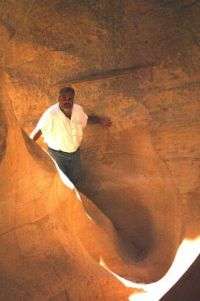Keeping Traditions in a Modern-Day Bedouin Village

University of Arkansas researchers have used modern digital-mapping technology to uncover an ancient tradition still practiced by a Bedouin tribe that once roamed Jordan but now has settled into a modern village. The findings appear to have no parallel anywhere.
Tom Paradise, professor of geosciences, and graduate student Chris Angel worked with the country of Jordan and the United Nations Educational, Scientific and Cultural Organization to create a digital map of the Bedouin city of Um Sayhun on a cliff that overlooks Petra, Jordan. When Petra became a World Heritage Site in 1985, a nomadic Bedouin tribe was spending part of the year living in some of the ancient structures. In creating the World Heritage Site, UNESCO helped relocate the Bedouin tribe to a nearby hilltop, which became Um Sayhun. Now, almost 20 years later, Paradise and Angel visited Um Sayhun and used satellite imagery to examine its structure.
On the ground, the village has undergone revolutionary change since the 1980s.
"It used to be little more than mortar and cinder blocks, with beat-up trucks out front," Paradise said.
Over the past 20 years, tribe members have opened travel agencies, restaurants and hotels - and they have accumulated wealth.
"Today, many people drive BMWs and Mercedes and have second homes," Paradise said.
The city landscape has transformed from tiny houses to magnificent three-story mansions. The origins of the village appear to have disappeared, and some express concern that many Bedouin traditions have disappeared as well.
However, when Paradise and Angel took to the air, they found something unusual - while the original structures from the 1980s were not visible, the city blocks appeared to be oval in shape.
"When walking through the village, you don't get the feeling that the house layouts are curved," Paradise said.
When they asked the clan sheikh about the unusual morphology, he told them: "We didn't want to leave our desert traditions behind because we were living in a city."
The researchers examined the city blocks, and realized that the fronts of the houses, which faced the streets, were not the least bit social; instead they found the hustle and bustle of everyday life in the interior courtyard of each city block. When they entered the interior of a city block, they found gardens, terraces and low walls. Moms cooked, kids played and neighbors socialized.
"That's where the action takes place," Paradise said.
This "action" looks much like what occurs in Bedouin desert camps, where the tents surround an inner courtyard designed to protect children and valuables from possible danger.
Paradise and Angel wanted to see who was living in these city blocks, which consisted of 20 to 40 houses, so they interviewed the inhabitants to determine the village structure.
"Everyone in a particular block was related through marriage or through blood" - more evidence of the preservation of their ancient culture, Paradise said. They could not find a parallel city structure anywhere.
"This appears to be the perfect setting for this: A 20-year-old city, where everyone moves at the same time to the same place with the same resources," Paradise said. The fact that modern amenities - including access to health care, satellite television and the Internet - have transformed the lives of these Bedouins, they continue to embed some of their traditions in the very foundations of their village.
Source: University of Arkansas




















